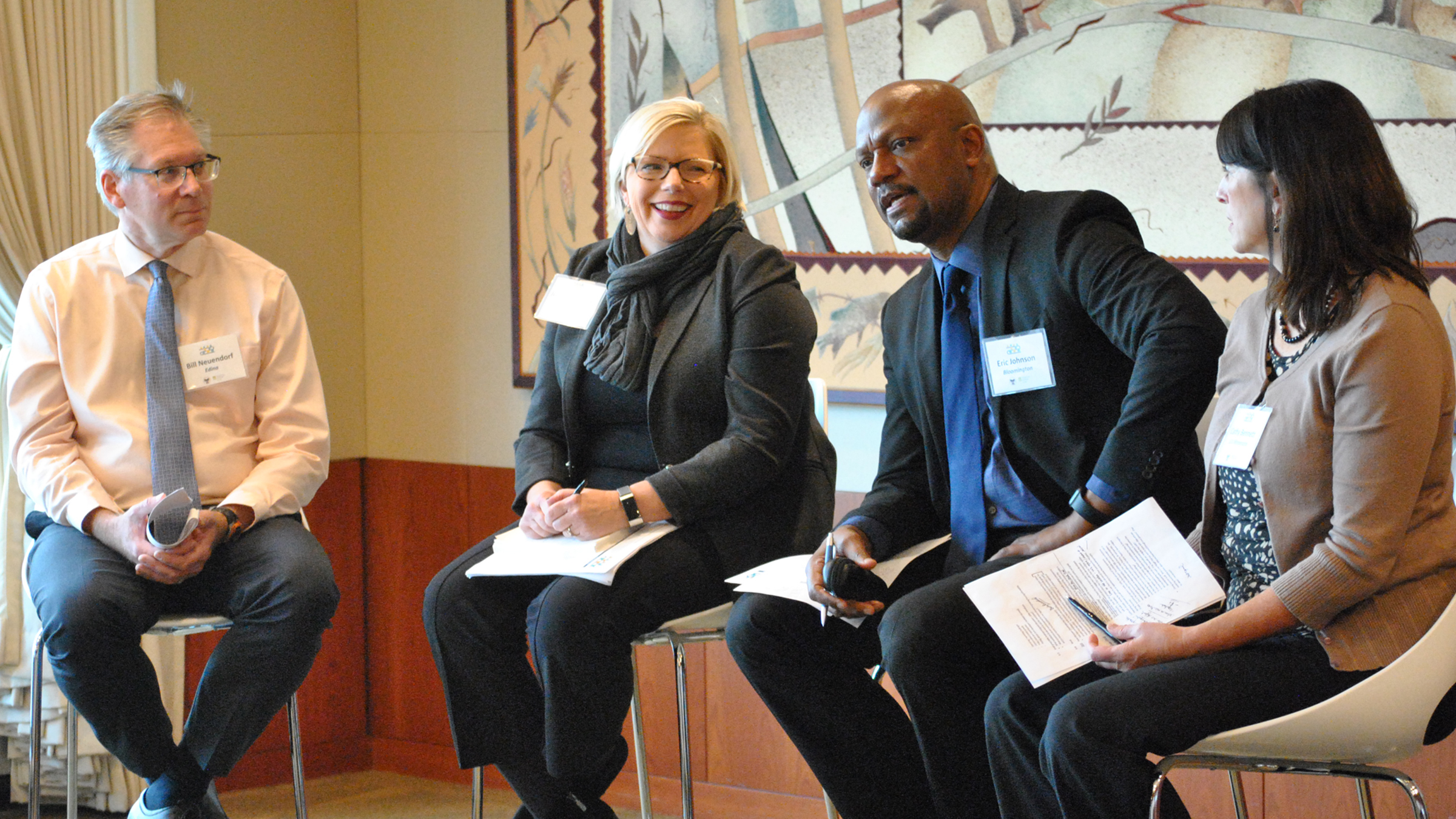Policymakers, academics, and community members gathered at the Federal Reserve Bank of Minneapolis on January 31 to discuss the regional, state-level, and local implications of America’s Rental Housing 2020, a report the Harvard University Joint Center for Housing Studies (JCHS) released at the event. The rental housing market trends detailed in the report will sound familiar to many in the Ninth Federal Reserve District.
“Almost everywhere I go, affordable housing comes up. If it’s not the number one issue, it’s in the top three,” remarked Minneapolis Fed President Neel Kashkari. Housing issues impact people across the income spectrum, he said, and many local leaders believe housing constraints are limiting their communities’ economic growth.
The report examines multiple data sources for the U.S. as a whole and contains breakouts for geographic regions, states, and some metro areas. The trends the report describes are largely reflected across the Ninth District: rent increases that outpace inflation, tighter rental markets, and changing renter demographics. The sum impact of these trends can result in local conditions that make it difficult for many households to find housing that fits comfortably within their budget—a fact reflected in the increasing share of renters who are housing-cost-burdened, or paying 30 percent or more of their gross income on rent.
In general, the report highlights trends that put upward pressure on prices. Nationally, the share of renter households earning more than $75,000 a year increased by nearly 50 percent from 2010 to 2018. At the same time, the value of land has increased, as have the costs of construction materials and labor. Both trends encourage multi-family housing builders to target a higher-income clientele.
—Tony Barranco, Ryan Companies
Local builders report similar developments. “It costs us 70 percent more to build a wood-frame, six-story apartment building today than it did seven or eight years ago,” said Tony Barranco, the senior vice president of real estate development at Minneapolis-based Ryan Companies, one of the region’s largest construction firms.
According to the report, developers are building more rental units than they have in decades, despite the price pressures—but not enough to keep up with a 10-million-household increase in renters over the past ten years.
“The supply side has responded to that growth,” said Christopher Herbert, the managing director of JCHS. “But based on demand, it seems like there certainly could have been more built.”
These trends and others highlighted in the report contribute to a decreasing supply of low-cost, nonsubsidized rental units—and point to an even lower supply of low-cost rental units in the future, as income-restricted units are expected to convert to market rate.
The report’s findings also point to important ways that local markets can diverge from national or even state trends.
“The report really highlights that housing isn’t just a coastal issue,” said Commissioner Jennifer Leimaile Ho of Minnesota Housing, the state’s housing finance agency.
For example, according to the Minneapolis Fed’s Ninth District-specific analysis of the same U.S. Census Bureau dataset the JCHS report’s authors used, rental vacancy rates in Minnesota, Montana, and South Dakota are noticeably lower than the already-low national vacancy rate. (See the interactive chart below comparing Ninth District states’ rates to the U.S. rate.) In the Twin Cities, apartments are scarce relative to demand, with vacancy rates comparable to those of Boston or New York City and lower than those of the nation and many metro markets, including Seattle, Denver, Atlanta, and Houston.
On the other hand, according to a recent business-news article focused on the Fargo-Moorhead area, North Dakota’s 14 percent vacancy rate is double that of its neighboring states and the U.S. as a whole. Vacancy rates recently hit long-term highs last year in Fargo, that state’s largest city, but are beginning to fall.1
The JCHS report also contains insights on people who rent their homes. Whites make up the largest share of renters. Across all races, renters are most likely to be under age 35, and the most likely household type is living alone with no children. However, from 2004 to 2018, nearly two-thirds of the increase in renter households came from people over the age of 55, and more than three-quarters of the increase in renter households came from households of color.
Here, too, Ninth District states differ from the national trends in notable ways. According to the Minneapolis Fed’s analysis, in Montana, the share of renter households headed by someone who is white did not change much from 2004 to 2018. In the Dakotas, meanwhile, the share of renter households headed by a person of color more than doubled.2
—Deidre Schmidt, CommonBond
Taken together, findings from the JCHS report detail a rental housing market drastically different from the one renters, landlords, and developers faced in the not-too-distant past. To address the current situation, “we have to think about who’s deciding where things are allowed to be built, and what we’re allowed to build there,” said Deidre Schmidt, president and CEO of CommonBond, one of the largest affordable housing providers in the Midwest.
Under the current policy and market environment, by Tony Barranco’s estimate, “$1.5 billion worth of housing needs to fall from the sky tomorrow” to address the Twin Cities’ low vacancy rate. “That’s 6,000 units, or a year’s supply,“ he said.
Reducing construction costs and complexities across the overall rental-housing market is one approach to increase the affordable options available to renters. Kashkari argued that “unlocking the private sector” by making it easier to build rental housing is vital to solving affordability problems for renters across the income spectrum. “We have evidence that even [increasing the supply of] luxury units can create opportunities for lower-income renters to find affordable units,” he said.
Kashkari also acknowledged the importance of income-targeted subsidies in housing people who may not earn enough to afford market-rate rentals. Whitney Airgood-Obrycki, one of the report’s authors, pointed out that there is not enough federal funding to meet demand for rental assistance. Only 1 in 4 households eligible for housing assistance receives it, she said.
Policymakers’ actions—and, in some cases, inaction—ultimately impact “who’s in, who’s out, and who has a home,” said Minnesota Lieutenant Governor Peggy Flanagan, who described how her family found a home when she was a child thanks to federal rental assistance. Her remarks highlighted the importance of framing housing policy conversations with a concept of “us” rather than “those people.”
That’s why, when discussing the price of new units or increased subsidies, it’s important to remember that “we are paying so much” when we don’t address affordability issues, said Ho. “We are paying in our schools, we are paying in our health care system, we are paying with a reduced level of economic competitiveness. We can’t afford not to do this.”
Mayor Jacob Frey of Minneapolis agreed. “It costs a county or a city three times as much for someone to cycle through shelter and services as it does to have them in stable housing,” he said.
Frey described another reason to invest in affordable housing—and to address economic and racial housing segregation that can be reinforced by policies like zoning and land use regulations. “I believe in diversity in neighborhoods—racial, yes, but diversity of all kinds,” he said. “The mix of ideas and opportunities is what it takes to create a truly great city.”
Endnotes
1 April Baumgarten, “Rental vacancy rates show Fargo-Moorhead has ‘a glut of apartments.’ Did developers overbuild?” InForum, August 4, 2019.
2 Author’s calculations based on U.S. Census Bureau American Community Survey data accessed through the IPUMS USA database.





